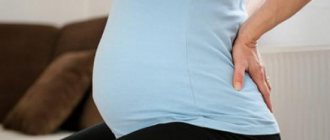How does a child develop?
This week, the baby actively continues to grow and gain weight, his height is already about 44 cm, and the weight of his tiny body is approximately 1,800-1,900 g. During this period, the baby is no longer so easy to turn around, he takes up more space, which is why his movements. This week the baby sleeps a lot and therefore moves less, and the amplitude of his movements decreases. The muscles become stronger, so the shocks, although rare, are quite strong and more concentrated. For the mother, the baby's movements can be very sensitive and painful, causing internal organs to suffer. The baby’s blood vessels are already expanding and contracting, their walls are becoming thicker and their tone is higher. Brain cells undergo a process of adhesion. The baby’s skin turns pink, and thanks to the increase in subcutaneous fat, all wrinkles on the body are smoothed out. The hairs on the baby's head become darker and thicker, and the hairs covering the body become less and less. This fluffy hair is called lanugo. At week 33, the baby’s skin is covered with a special lubricant that protects it and ensures an easier birth. The lubricant mostly covers the face, back, folds under the arms, groin and neck.
29,30,31,32 weeks of pregnancy: what happens, development of pregnancy and fetus
- home
- Services and prices
- Services and prices
- About Us
- Doctors
- Schedule and appointments
- Reviews
- Doctor training
- Clinic addresses
- Blog
- CIropedia
Week by week 29 - 32 weeks of pregnancy Elena Gevorkova Obstetrician-gynecologist, Moscow
Week 29
BABY
The length of the fetus is 36-37 cm, and the body weight is 1200-1300 g. By this time, the baby’s skin becomes smoother, as subcutaneous fat continues to accumulate, smoothing out all wrinkles and folds. The body of the fetus is covered with vellus hair, but its number is already less than in earlier stages. On the contrary, the hair on the head thickens, grows and darkens. The baby blinks frequently, opening his eyes wide.
By this time, fetal movements become less active, frequent and intense tremors are replaced by smoother movements: the baby straightens his arms and legs, protrudes his head and pelvic end.
There is little free space in the uterus, and the fetus, which has reached quite large sizes by this time, is forced to remain in one position most of the time. Since its head is heavier than the buttocks, the fetus takes a head-down position in the watery space of the uterus - this is the so-called cephalic presentation. At this stage, there are frequent situations of breech presentation, when the legs and buttocks of the fetus are located at the bottom of the uterus. Most often, in the following weeks, the child turns over, taking a physiological cephalic presentation. In some cases, this does not happen, and the baby “sits on his butt” until full term. Breech presentation will play an important role when choosing a delivery option. EXPECTANT MOTHER
The intensive growth of the uterus continues, and the internal organs located in the vicinity of the uterus continue to experience discomfort. In the most cramped conditions are the “neighbors” of the uterus - the stomach, bladder and lower part of the large intestine: these are organs with a cavity inside. They are displaced by the growing uterus and take a forced position, which can affect their work.
“Suffering” of the stomach can be manifested by heartburn, a feeling of heaviness after eating. Heartburn is discomfort that occurs when stomach contents reflux into the esophagus. This condition is manifested by a burning sensation and an unpleasant taste in the mouth. During pregnancy, the muscle that separates the esophagus from the stomach, under the influence of hormones, in particular progesterone, relaxes, which makes it possible for the acidic contents of the stomach to flow “from the bottom up” into the esophagus. Changing the position of the stomach aggravates this situation. That is why the expectant mother should eat small portions, chewing her food thoroughly - this will significantly alleviate her condition. Increasing pressure on the bladder causes frequent urination, which can accompany the pregnant woman until childbirth. False urges are also possible, when the brain sends a signal about the need to urinate, but the bladder is not yet full and there is no urine output at all or in very small quantities. During pregnancy, the situation of frequent and painless urination is not a sign of any disease. When other symptoms occur: cloudy urine, pain, etc. - You should inform your doctor about this to rule out pyelonephritis and other diseases.
30th week
BABY
The baby's height this week is 37-38 cm, and body weight is about 1300-1400 g. At the 30th week, an intensive increase in muscle mass occurs, and frequent movements of the fetus are designed to train the muscles of the limbs, since by the time of birth the baby should have strong muscles of the arms, legs, chest, back. The expulsion of the fetus (the so-called second stage of labor - the direct birth of the child) is carried out due to contraction of the uterus, the muscles of the abdominal wall and the independent movements of the baby. The high tone of the muscles of the fetal body makes it easier to make forward movements, facilitating movement along the birth canal.
Also during this period, preparation for extrauterine life of internal organs continues. The chest makes movements similar to breathing - it expands and contracts. The lungs are washed with amniotic fluid, and the production of surfactant, a special substance that ensures pulmonary respiration, continues. Alveoli, the vesicles of lung tissue in which gas exchange occurs, develop intensively. Readiness for independent breathing is the most important indicator of fetal survival. If for some reason childbirth occurs at this stage, then the maturity of the lung tissue is already capable of ensuring the breathing of the newborn.
The fetus constantly swallows amniotic fluid, which causes the organs of the gastrointestinal tract to contract and stimulates the functioning of the liver and pancreas. The liver performs the most important function of purifying the blood and at this stage is ready to function in full, since the formation of this organ, or more precisely, the liver lobules as a structural unit, is almost complete by this time. The pancreas produces enzymes and hormones, the most important of which is insulin, in small quantities, since during pregnancy the fetus only needs to process amniotic fluid, which requires a small amount of enzymes. But potentially the pancreas at this stage is already ready to fully supply the newborn’s body.
The constant supply of amniotic fluid forces the kidneys to function intensively and produce urine from the liquid part of the amniotic fluid.
The amount of urine during this period can reach up to 500 ml per day. Thus, during this period, the internal organs are able to ensure the vital functions of the newborn in the event of childbirth, but the process of their maturation and improvement will continue until full term. EXPECTANT MOTHER
Pregnant women may notice swelling of the breasts and the release of colostrum from the nipples: this is the name for the secretion of the mammary glands, “primary milk”. Colostrum appears as a thick, whitish or yellowish liquid. Its release can begin at different stages of pregnancy, but most often it occurs after the 30th week. The appearance of colostrum indicates that a woman is actively preparing for lactation—feeding her baby with breast milk. In the first days after birth, colostrum is released more intensely and precedes the appearance of breast milk.
During pregnancy, colostrum production is stimulated directly by the fetus. His adrenal glands synthesize a special hormone that interacts with the hormones of the placenta and activates the production of prolactin, a hormone from the mother’s pituitary gland responsible for milk production. It is he who will be responsible for breastfeeding after childbirth.
At 30 weeks pregnant women are issued a certificate of temporary incapacity for work - maternity leave is issued. Its duration is 140 days - 70 days before and 70 days after childbirth.
31st week
BABY
The body length of the fetus is 39-40 cm, and the weight is 1500-1600 g. During this period, important stages of the formation of the fetal nervous system continue.
The brain grows rapidly, the convolutions deepen, increasing the surface area of the cerebral cortex. The brain and all its parts function as a single system; such interaction is ensured by many nerve connections. By this time, the periods of sleep and wakefulness alternate quite clearly, and sleep still takes a longer time than the period of activity. During sleep, the fetus's eyes are closed, and during wakefulness the baby opens them. The eyelids are already very well developed, which makes a variety of movements possible: the fetus can open its eyes wide, squint, squint, and blink frequently. As a rule, the fetus's eyes are always open, and he closes his eyes when bright light hits the mother's stomach or when the surface of the eye is touched: this is another evidence of the high development of the nervous system - the corneal reflex. EXPECTANT MOTHER
The increase in body weight by this period is approximately 7-8 kg. It is necessary to monitor the intensity of weight gain, since too rapid weight gain may indicate poor kidney function. The weekly increase should not exceed 300-400 g per week. You should be very careful about the appearance of swelling in your arms and legs and report it to your doctor. Fluid retention in a pregnant woman's body can become the first stage of complications in the second half of pregnancy - gestosis, which is also called late toxicosis. In addition to edema, signs of mild to moderate gestosis also include increased blood pressure and the appearance of protein in the urine.
The initial stages of gestosis can occur without pronounced changes, and the pregnant woman can feel great without complaining. This is why regular visits to the doctor and timely testing are so important. Preeclampsia is the most common cause of complications for both the fetus and the mother. As a result, the baby may experience developmental delay, hypoxia, etc., and the woman may experience impaired renal, liver, cardiovascular system function and other dangerous conditions.
A mild degree of gestosis, dropsy in pregnancy, is characterized by the appearance of edema and can be corrected by normalizing water-salt metabolism: for this, the expectant mother can be prescribed a diet, herbal preparations, etc.
Moderate and severe degrees of gestosis - nephropathy, preeclampsia and eclampsia - require intensive care in a hospital setting. Nephropathy in pregnant women is characterized by the fact that the edema present at the stage of dropsy is accompanied by episodes of increased pressure and the appearance of protein in a general urine test.
With further progression of gestosis, a severe degree of nephropathy turns into preeclampsia - a condition for which, in addition to severe edema, high blood pressure and protein in the urine, is characterized by signs of cerebrovascular accident: dizziness, headaches, as well as neurological symptoms - changes in reflexes, nausea and vomiting .
The most severe stage of gestosis, eclampsia, is characterized by the presence of convulsive seizures followed by the development of coma.
It is extremely important to detect signs of gestosis at an early stage and be sure to treat this condition, since the increase in complications can occur quickly and lead to serious and sometimes irreversible consequences.
Week 32
BABY
The fetus at this stage weighs 1700-1800 g, and its body length reaches 41-42 cm. The baby's facial features are close to the appearance of a newborn child, the face becomes rounded, wrinkles are smoothed out, and the hair on the head is noticeably pronounced. The skin of the fetus is no longer bright red, but pink due to the even distribution of subcutaneous fat. The accumulation of such fat is essential for the process of thermogenesis - maintaining body temperature at a constant level. In adults, these processes are controlled by the brain - thermoregulation centers. By the time the baby is born, these centers are not yet able to fully provide thermoregulation, and that is why the presence of subcutaneous fat is extremely important for maintaining the correct body temperature of the fetus.
The period of 32 weeks is marked by important stages in the functioning of the immune system.
In the fetal blood there is a sharp increase in the level of its own immunoglobulins - special proteins that protect the baby from infections. By the time of birth, the level of immunoglobulins will increase, but this will happen due to the penetration of mother’s immunoglobulins into the fetus’s body. In the last weeks of pregnancy, the permeability of the placental barrier increases, which allows the protective cells of the mother's body to pass into the baby's blood. EXPECTANT MOTHER
Pain in the back, in the pubic area and large joints, such as the hip, knee, a feeling of fullness and pain in the pelvic bones - these phenomena are present to one degree or another in many pregnant women in the third trimester. A change in the center of gravity of a woman’s body due to an increase in the volume of the abdomen leads to some displacement of the spine, which entails the above-mentioned problems. On top of that, the mother’s body begins preparing for childbirth by producing the placental hormone, relaxin. It causes the ligaments to relax, and during childbirth the pelvis becomes more pliable, which ensures the free passage of the baby through the birth canal. During pregnancy, high levels of the hormone relaxin “loose” the ligaments, which results in painful sensations.
Regular physical activity - fitness, yoga, swimming, walking - will help reduce the manifestations of such ailments. The stronger the back muscles, the better they will support the spine and the less pregnant women will feel pain and discomfort in the lumbar region.
At this time, it is recommended to wear a bandage and choose the correct position while sleeping: it is advisable to sleep on your side so that there is no load on the spine and the back muscles are in a relaxed state. It is possible to use special back bolsters or pillows for pregnant women: these devices will help the expectant mother find a comfortable position that allows her to relax the muscles of her back and legs, and cope with a frequent companion of the third trimester - back pain.
How does mom feel?
The uterus of the expectant mother rises higher and higher, to a distance of up to 34 cm from the pubis, and the tummy grows significantly. This is due to the large weight of the baby, amniotic fluid and placenta. At the same time, it is harder for mom to squat and make other movements. Strong and sudden kicks from the baby, as well as an enlarged uterus, can cause pain. But the expectant mother can already determine what exactly the baby pushed her with: his knee or his fist. If the kicks are light, this may indicate that the baby is hiccupping. At this time, the woman is recommended to do light physical activity, which allows for frequent breaks. Hiking or fitness is best. Due to the fact that the enlarged uterus puts pressure on many organs, the mother may experience temporary discomfort, which is not related to any diseases. A high load is placed on the spine, causing pain in the sacrum, lower back and pelvis. A pregnant woman has a liter more circulating blood volume, which has a strong effect on the functioning of the kidneys, oppressing the bladder and causing frequent urination. Sometimes mom can get up up to six times a night. The cause of heaviness in the stomach, heartburn and nausea is the pressure of the uterus on the stomach. In this case, frequent meals in small portions will help alleviate the condition.
Future mom
By this time, the weight of the expectant mother increases by 7-8 kg. For pregnant women, it is important to monitor the rate of weight gain, because too much weight gain may indicate poor kidney function. So, per week the weight should increase by no more than 300-400 g. In addition, it is important to monitor the presence of swelling in the extremities and, if they are detected, notify the doctor. Fluid retention is a sign of pregnancy complications. Preeclampsia, which is also called late toxicosis, is characterized not only by swelling, but also by increased blood pressure, as well as the appearance of protein in the urine.
In the initial stages, gestosis can be completely asymptomatic, so a pregnant woman may not notice any changes at all and feel great. That is why it is important to constantly visit a doctor who can, based on tests, determine the presence of late toxicosis. Preeclampsia is one of the main causes of complications in both the mother and her child. It can provoke delayed fetal development, hypoxia, and negatively affect the functioning of the kidneys, vascular system and heart, as well as the woman’s liver.
Mild gestosis manifests itself in the form of edema. It can be corrected by normalizing water-salt metabolism. The doctor may prescribe special diets for the pregnant woman, as well as medications that will help cope with this condition.
Moderate or severe gestosis (nephropathy, preeclampsia and eclampsia) requires urgent hospitalization. Intensive therapy is provided in a hospital setting. Nephropathy in the expectant mother manifests itself not only in the form of edema, but also high blood pressure, as well as the appearance of protein in the urine, which is detected during tests.
Active progression of gestosis can cause severe nephropathy, which gradually develops into preeclampsia. This condition is manifested not only by edema, high blood pressure, protein in the urine, but also by circulatory disorders in the brain. Women report frequent dizziness, pain, as well as nausea, vomiting, and changes in reflexes.
Preeclampsia at its most severe stage (eclampsia) is characterized by the manifestation of convulsive seizures, which can cause coma. That is why it is important for a pregnant woman to detect signs of gestosis in the early stages in order to avoid an increase in symptoms, which in the future can lead to irreversible consequences.
How does mom feel?
This week of pregnancy requires conscientious monitoring of the condition of the expectant mother. This is exactly the period when a woman can feel false contractions. Painful sensations appear in the upper part of the uterus and gradually subside. As pregnancy progresses, contractions become more pronounced. They resemble short muscle contractions lasting from a few seconds to five minutes. In this way, the body prepares for the upcoming birth. This process accompanies every woman’s pregnancy with varying intensity. Experts call this Braxton-Hicks contractions. How can an expectant mother distinguish labor pains from warning signs, especially if she is expecting a baby for the first time?
Let's look at the main differences:
- Preparatory contractions are characterized by a high interval between them, which varies in duration. And prenatal contractions are regular, with a gradually decreasing interval.
- Preparatory contractions may stop immediately after resting or changing the body position of the expectant mother, and labor contractions gradually intensify regardless of the change in position.
- The pain sensations are also different. Labor pains are accompanied by severe pain, which becomes more and more noticeable. Preparatory contractions are characterized by either sharp pain or can be completely painless.
- False contractions can stop with the use of antispasmodics approved by doctors. While such drugs will not have any effect on labor contractions or will be minimized.
- A woman can feel false contractions in various places. This could be the lower abdomen, the side walls of the uterus, or the entire abdomen. Pain during labor may resemble premenstrual pain. Also, pain may begin in the lower back, gradually covering the front of the abdomen.
It is very important for a woman with such symptoms to provide a sense of security; in case of any contractions, the pregnant gynecologist must be informed.
Future mom
The third trimester of pregnancy can be manifested by pain in the back, pubic area, as well as knee and hip joints. There may also be a feeling of bursting of the pelvic bones and pain. Such phenomena are present in many pregnant women, since the center of gravity changes and the spine shifts (due to the growth of the abdomen). At week 32, the woman’s body is already actively preparing, producing the placental hormone - relaxin, which is responsible for relaxing the ligaments, making the pelvis pliable during childbirth and thereby ensuring the easiest and most comfortable movement of the baby through the birth canal. Too much of this hormone causes pain and loosening of the ligaments. That is why pregnant women are recommended to undergo regular physical activity in the form of walking, yoga, fitness, and swimming. Strong muscles will be able to support the spine, and will also reduce discomfort in the lumbar region and pain. Doctors recommend that women wear a brace and sleep on their side to avoid significant stress on their back. Also, special devices (pillows, bolsters) will not be superfluous, which will allow the expectant mother to fully rest at night, take a comfortable position that will help relax the muscles of the back and legs.
How does mom feel?
During this period, the mother has difficulty breathing. This is caused by the growing uterus, which pushes aside the lungs first. The lungs cannot fully expand, making breathing difficult. Also, the enlarged uterus pushes aside the bladder and intestines. This week, almost every pregnant woman feels short of air, has shallow and rapid breathing and a constant desire to take a deep breath. The cause of shortness of breath during this period may be a long walk or climbing stairs, as well as prolonged lying down. A competent alternation of rest and physical activity will help alleviate the condition. The fundus of the uterus rises 35 cm from the pubis and 15 cm from the navel, this is the highest point during the entire period of bearing a baby. This feels like one of the most difficult weeks of pregnancy. The body of the expectant mother is actively preparing for the upcoming birth, all ligaments become more extensible and elastic. It can also lead to an increased risk of injury and falls. During this period, doctors do not recommend flying or long trips. If you need to go somewhere, it is important to have a loved one present and to change your position approximately every 15 minutes. This week, mom needs to rest more often. Special physical exercises will be useful to help reduce back pain.
Mom's feelings and well-being
The size of the uterus is so large that the growing belly puts pressure on the lungs. Hence the shortness of breath, which can be very severe. The mother’s body continues to intensively produce hormones; for her, the changes are not yet complete. In this regard, a woman may experience the following problems:
- Problems with sleep and mood. Mom is worried about childbirth. In addition, its rhythm often does not coincide with the child’s intentions. As soon as the woman gets ready to sleep, the baby wants to make himself known. And its activity does not contribute to restful sleep. Therefore, mom should use every moment to fully relax.
- Due to the heavy weight and large belly, it is difficult to move. Long walks are no longer possible, and it is not recommended to go far from home at this time. But you shouldn’t completely give up walking and physical activity.
- Many women are bothered by stretch marks. It can be located on the stomach and chest, even on the inner thighs. The best way to combat stretch marks is prevention. You should consult your doctor in advance about wearing a bandage and using anti-stretch marks.
- Often my mother suffers from heartburn. It is better to avoid fried, smoked, salty and sour foods. Dishes should be steamed, eaten in small portions and more often.
- Swelling is associated not only with increased exercise, but also with improper fluid intake. It is important to control your drinking regime as prescribed by your doctor.
- Heaviness in the legs and fatigue can be removed by placing them on an elevated surface.
At the 35th week of pregnancy, a woman may experience discharge. If they do not have a specific odor and are transparent, this is normal. If blood streaks or clots appear in the discharge, you should immediately call an ambulance.
Important! At this time, the next scheduled ultrasound is prescribed. The doctor must make sure that the degree of maturity of the placenta corresponds to the term and that it is functioning normally.
Ultrasound examination also helps determine whether the fetal weight corresponds to the gestational age. The doctor listens to the baby's heartbeat and confirms that there are no abnormalities in his development. During the examination, the presentation of the baby is finally determined. According to the results, the method of birth is determined - natural or cesarean section.
Despite a number of difficulties, mother can enjoy her position. After all, she has already established a close connection with the child, and there is no reason to worry about his development. He knows who he is expecting - a girl, a boy, or several children at once. A woman prepares everything her soon-to-be-born baby will need.
How does mom feel?
During this period, a pregnant woman feels very tired. The tummy becomes heavier, making it difficult to choose a body position. The baby begins to sink lower, preparing for birth, and the mother begins to breathe easier. But this increases pressure on the bladder, causing more frequent urination. The uterus is located at a distance of 36 cm from the pubis. This is the highest point during the entire pregnancy. The body of the expectant mother is being rebuilt, making intensive preparations for childbirth. Hormonal changes cause an increase in hormone levels. The pelvic bones soften under the influence of hormones, trying to make it as easy as possible for the baby to pass through the birth canal. At the same time, contractions intensify and more abundant vaginal discharge appears. A pregnant woman this week needs to listen more to her body and carefully monitor it. If you have nagging pain in the lower abdomen, as well as pain in the lower back, you should pay attention to its duration and frequency. If all indicators are present, you should immediately contact a gynecologist: premature birth is not uncommon this week, so it is important to respond to the body’s signals in a timely manner. Mom should be very careful: do not make sudden movements, control her posture, moderate walks and sitting time. During this period, sleep is disturbed, thus the body also prepares for the baby’s night feedings. This week, mom can fully feel what swelling is. It is necessary to control swelling, which can cause organ dysfunction.
What are the first signs of pregnancy?
Unprotected intercourse leads to pregnancy in 40% of cases, but determining whether conception occurred during the first few weeks is quite difficult. Even a pregnancy test will not always be able to clarify the situation, because it must be carried out starting from a missed period. The only way to find out if you are pregnant with a 100% probability is to visit a doctor, but, unfortunately, it is not always possible to make an appointment with a doctor on the same day.
The first signs of pregnancy can make themselves felt almost immediately after conception, and in order not to suffer from the unknown, you just need to listen to your body. True, in most women these signs appear only at the end of the first month of pregnancy, and may not make themselves felt at all. It is possible to reliably find out whether you are pregnant only after implantation of the embryo and the beginning of a large-scale restructuring of the female body. A woman’s hormonal background changes significantly: in order for pregnancy to pass without complications, the entire body must prepare for intensive work for nine months.
A gestational dominant, or pregnancy dominant, occurs. Simply put, this is a program embedded in the nervous system in order to maintain the vital activity of the embryo, and then the fetus. The gestational dominant is formed immediately after implantation of the embryo into the uterine mucosa due to constant nerve impulses. This phenomenon serves as the beginning of changes in the life of the expectant mother, manifesting itself in several signs that are often found in the early stages of pregnancy.









